Da-Wei Zhou
The Lie of the Average: How Class Incremental Learning Evaluation Deceives You?
Sep 26, 2025Abstract:Class Incremental Learning (CIL) requires models to continuously learn new classes without forgetting previously learned ones, while maintaining stable performance across all possible class sequences. In real-world settings, the order in which classes arrive is diverse and unpredictable, and model performance can vary substantially across different sequences. Yet mainstream evaluation protocols calculate mean and variance from only a small set of randomly sampled sequences. Our theoretical analysis and empirical results demonstrate that this sampling strategy fails to capture the full performance range, resulting in biased mean estimates and a severe underestimation of the true variance in the performance distribution. We therefore contend that a robust CIL evaluation protocol should accurately characterize and estimate the entire performance distribution. To this end, we introduce the concept of extreme sequences and provide theoretical justification for their crucial role in the reliable evaluation of CIL. Moreover, we observe a consistent positive correlation between inter-task similarity and model performance, a relation that can be leveraged to guide the search for extreme sequences. Building on these insights, we propose EDGE (Extreme case-based Distribution and Generalization Evaluation), an evaluation protocol that adaptively identifies and samples extreme class sequences using inter-task similarity, offering a closer approximation of the ground-truth performance distribution. Extensive experiments demonstrate that EDGE effectively captures performance extremes and yields more accurate estimates of distributional boundaries, providing actionable insights for model selection and robustness checking. Our code is available at https://github.com/AIGNLAI/EDGE.
Hierarchical Representation Matching for CLIP-based Class-Incremental Learning
Sep 26, 2025Abstract:Class-Incremental Learning (CIL) aims to endow models with the ability to continuously adapt to evolving data streams. Recent advances in pre-trained vision-language models (e.g., CLIP) provide a powerful foundation for this task. However, existing approaches often rely on simplistic templates, such as "a photo of a [CLASS]", which overlook the hierarchical nature of visual concepts. For example, recognizing "cat" versus "car" depends on coarse-grained cues, while distinguishing "cat" from "lion" requires fine-grained details. Similarly, the current feature mapping in CLIP relies solely on the representation from the last layer, neglecting the hierarchical information contained in earlier layers. In this work, we introduce HiErarchical Representation MAtchiNg (HERMAN) for CLIP-based CIL. Our approach leverages LLMs to recursively generate discriminative textual descriptors, thereby augmenting the semantic space with explicit hierarchical cues. These descriptors are matched to different levels of the semantic hierarchy and adaptively routed based on task-specific requirements, enabling precise discrimination while alleviating catastrophic forgetting in incremental tasks. Extensive experiments on multiple benchmarks demonstrate that our method consistently achieves state-of-the-art performance.
Integrating Task-Specific and Universal Adapters for Pre-Trained Model-based Class-Incremental Learning
Aug 11, 2025Abstract:Class-Incremental Learning (CIL) requires a learning system to continually learn new classes without forgetting. Existing pre-trained model-based CIL methods often freeze the pre-trained network and adapt to incremental tasks using additional lightweight modules such as adapters. However, incorrect module selection during inference hurts performance, and task-specific modules often overlook shared general knowledge, leading to errors on distinguishing between similar classes across tasks. To address the aforementioned challenges, we propose integrating Task-Specific and Universal Adapters (TUNA) in this paper. Specifically, we train task-specific adapters to capture the most crucial features relevant to their respective tasks and introduce an entropy-based selection mechanism to choose the most suitable adapter. Furthermore, we leverage an adapter fusion strategy to construct a universal adapter, which encodes the most discriminative features shared across tasks. We combine task-specific and universal adapter predictions to harness both specialized and general knowledge during inference. Extensive experiments on various benchmark datasets demonstrate the state-of-the-art performance of our approach. Code is available at: https://github.com/LAMDA-CL/ICCV2025-TUNA
Addressing Imbalanced Domain-Incremental Learning through Dual-Balance Collaborative Experts
Jul 09, 2025Abstract:Domain-Incremental Learning (DIL) focuses on continual learning in non-stationary environments, requiring models to adjust to evolving domains while preserving historical knowledge. DIL faces two critical challenges in the context of imbalanced data: intra-domain class imbalance and cross-domain class distribution shifts. These challenges significantly hinder model performance, as intra-domain imbalance leads to underfitting of few-shot classes, while cross-domain shifts require maintaining well-learned many-shot classes and transferring knowledge to improve few-shot class performance in old domains. To overcome these challenges, we introduce the Dual-Balance Collaborative Experts (DCE) framework. DCE employs a frequency-aware expert group, where each expert is guided by specialized loss functions to learn features for specific frequency groups, effectively addressing intra-domain class imbalance. Subsequently, a dynamic expert selector is learned by synthesizing pseudo-features through balanced Gaussian sampling from historical class statistics. This mechanism navigates the trade-off between preserving many-shot knowledge of previous domains and leveraging new data to improve few-shot class performance in earlier tasks. Extensive experimental results on four benchmark datasets demonstrate DCE's state-of-the-art performance.
External Knowledge Injection for CLIP-Based Class-Incremental Learning
Mar 11, 2025Abstract:Class-Incremental Learning (CIL) enables learning systems to continuously adapt to evolving data streams. With the advancement of pre-training, leveraging pre-trained vision-language models (e.g., CLIP) offers a promising starting point for CIL. However, CLIP makes decisions by matching visual embeddings to class names, overlooking the rich contextual information conveyed through language. For instance, the concept of ``cat'' can be decomposed into features like tail, fur, and face for recognition. Besides, since the model is continually updated, these detailed features are overwritten in CIL, requiring external knowledge for compensation. In this paper, we introduce ExterNal knowledGe INjEction (ENGINE) for CLIP-based CIL. To enhance knowledge transfer from outside the dataset, we propose a dual-branch injection tuning framework that encodes informative knowledge from both visual and textual modalities. The visual branch is enhanced with data augmentation to enrich the visual features, while the textual branch leverages GPT-4 to rewrite discriminative descriptors. In addition to this on-the-fly knowledge injection, we also implement post-tuning knowledge by re-ranking the prediction results during inference. With the injected knowledge, the model can better capture informative features for downstream tasks as data evolves. Extensive experiments demonstrate the state-of-the-art performance of ENGINE. Code is available at: https://github.com/RenaissCode/ENGINE
MOS: Model Surgery for Pre-Trained Model-Based Class-Incremental Learning
Dec 12, 2024Abstract:Class-Incremental Learning (CIL) requires models to continually acquire knowledge of new classes without forgetting old ones. Despite Pre-trained Models (PTMs) have shown excellent performance in CIL, catastrophic forgetting still occurs as the model learns new concepts. Existing work seeks to utilize lightweight components to adjust the PTM, while the forgetting phenomenon still comes from {\em parameter and retrieval} levels. Specifically, iterative updates of the model result in parameter drift, while mistakenly retrieving irrelevant modules leads to the mismatch during inference. To this end, we propose MOdel Surgery (MOS) to rescue the model from forgetting previous knowledge. By training task-specific adapters, we continually adjust the PTM to downstream tasks. To mitigate parameter-level forgetting, we present an adapter merging approach to learn task-specific adapters, which aims to bridge the gap between different components while reserve task-specific information. Besides, to address retrieval-level forgetting, we introduce a training-free self-refined adapter retrieval mechanism during inference, which leverages the model's inherent ability for better adapter retrieval. By jointly rectifying the model with those steps, MOS can robustly resist catastrophic forgetting in the learning process. Extensive experiments on seven benchmark datasets validate MOS's state-of-the-art performance. Code is available at: https://github.com/sun-hailong/AAAI25-MOS
Dual Consolidation for Pre-Trained Model-Based Domain-Incremental Learning
Oct 01, 2024Abstract:Domain-Incremental Learning (DIL) involves the progressive adaptation of a model to new concepts across different domains. While recent advances in pre-trained models provide a solid foundation for DIL, learning new concepts often results in the catastrophic forgetting of pre-trained knowledge. Specifically, sequential model updates can overwrite both the representation and the classifier with knowledge from the latest domain. Thus, it is crucial to develop a representation and corresponding classifier that accommodate all seen domains throughout the learning process. To this end, we propose DUal ConsolidaTion (Duct) to unify and consolidate historical knowledge at both the representation and classifier levels. By merging the backbone of different stages, we create a representation space suitable for multiple domains incrementally. The merged representation serves as a balanced intermediary that captures task-specific features from all seen domains. Additionally, to address the mismatch between consolidated embeddings and the classifier, we introduce an extra classifier consolidation process. Leveraging class-wise semantic information, we estimate the classifier weights of old domains within the latest embedding space. By merging historical and estimated classifiers, we align them with the consolidated embedding space, facilitating incremental classification. Extensive experimental results on four benchmark datasets demonstrate Duct's state-of-the-art performance.
Adaptive Adapter Routing for Long-Tailed Class-Incremental Learning
Sep 11, 2024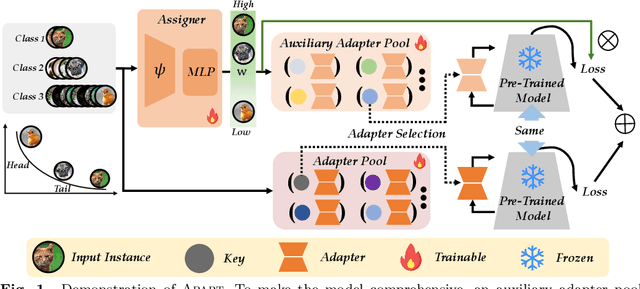

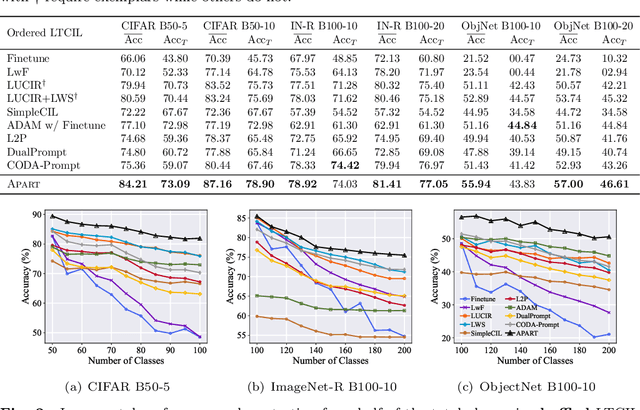
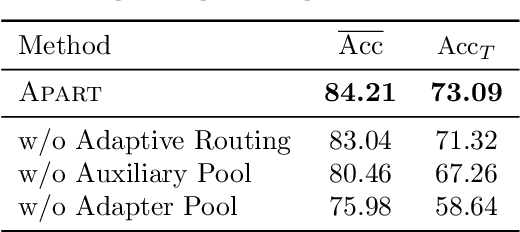
Abstract:In our ever-evolving world, new data exhibits a long-tailed distribution, such as e-commerce platform reviews. This necessitates continuous model learning imbalanced data without forgetting, addressing the challenge of long-tailed class-incremental learning (LTCIL). Existing methods often rely on retraining linear classifiers with former data, which is impractical in real-world settings. In this paper, we harness the potent representation capabilities of pre-trained models and introduce AdaPtive Adapter RouTing (APART) as an exemplar-free solution for LTCIL. To counteract forgetting, we train inserted adapters with frozen pre-trained weights for deeper adaptation and maintain a pool of adapters for selection during sequential model updates. Additionally, we present an auxiliary adapter pool designed for effective generalization, especially on minority classes. Adaptive instance routing across these pools captures crucial correlations, facilitating a comprehensive representation of all classes. Consequently, APART tackles the imbalance problem as well as catastrophic forgetting in a unified framework. Extensive benchmark experiments validate the effectiveness of APART. Code is available at: https://github.com/vita-qzh/APART
Parrot: Multilingual Visual Instruction Tuning
Jun 04, 2024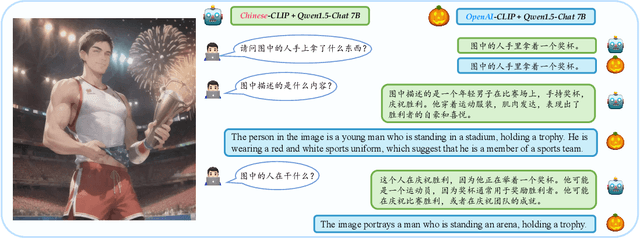
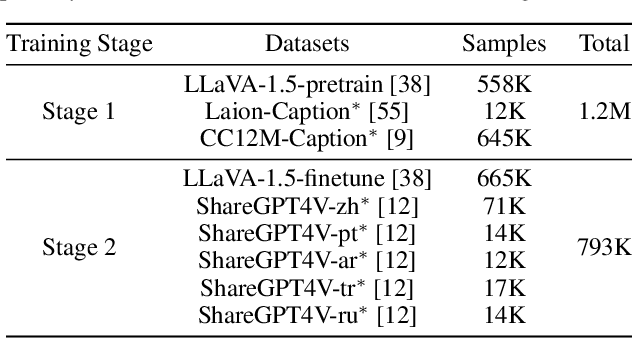

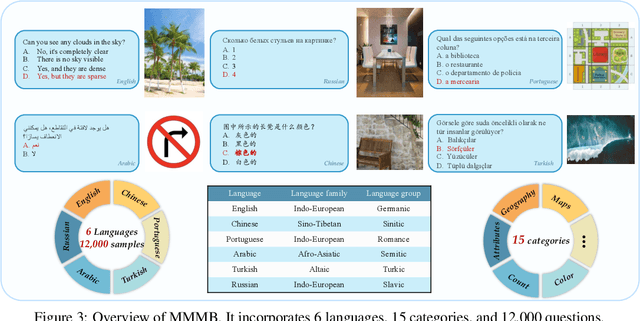
Abstract:The rapid development of Multimodal Large Language Models (MLLMs) like GPT-4V has marked a significant step towards artificial general intelligence. Existing methods mainly focus on aligning vision encoders with LLMs through supervised fine-tuning (SFT) to endow LLMs with multimodal abilities, making MLLMs' inherent ability to react to multiple languages progressively deteriorate as the training process evolves. We empirically find that the imbalanced SFT datasets, primarily composed of English-centric image-text pairs, lead to significantly reduced performance in non-English languages. This is due to the failure of aligning the vision encoder and LLM with multilingual tokens during the SFT process. In this paper, we introduce Parrot, a novel method that utilizes textual guidance to drive visual token alignment at the language level. Parrot makes the visual tokens condition on diverse language inputs and uses Mixture-of-Experts (MoE) to promote the alignment of multilingual tokens. Specifically, to enhance non-English visual tokens alignment, we compute the cross-attention using the initial visual features and textual embeddings, the result of which is then fed into the MoE router to select the most relevant experts. The selected experts subsequently convert the initial visual tokens into language-specific visual tokens. Moreover, considering the current lack of benchmarks for evaluating multilingual capabilities within the field, we collect and make available a Massive Multilingual Multimodal Benchmark which includes 6 languages, 15 categories, and 12,000 questions, named as MMMB. Our method not only demonstrates state-of-the-art performance on multilingual MMBench and MMMB, but also excels across a broad range of multimodal tasks. Both the source code and the training dataset of Parrot will be made publicly available.
TV100: A TV Series Dataset that Pre-Trained CLIP Has Not Seen
Apr 16, 2024Abstract:The era of pre-trained models has ushered in a wealth of new insights for the machine learning community. Among the myriad of questions that arise, one of paramount importance is: 'Do pre-trained models possess comprehensive knowledge?' This paper seeks to address this crucial inquiry. In line with our objective, we have made publicly available a novel dataset comprised of images from TV series released post-2021. This dataset holds significant potential for use in various research areas, including the evaluation of incremental learning, novel class discovery, and long-tailed learning, among others. Project page: https://tv-100.github.io/
 Add to Chrome
Add to Chrome Add to Firefox
Add to Firefox Add to Edge
Add to Edge